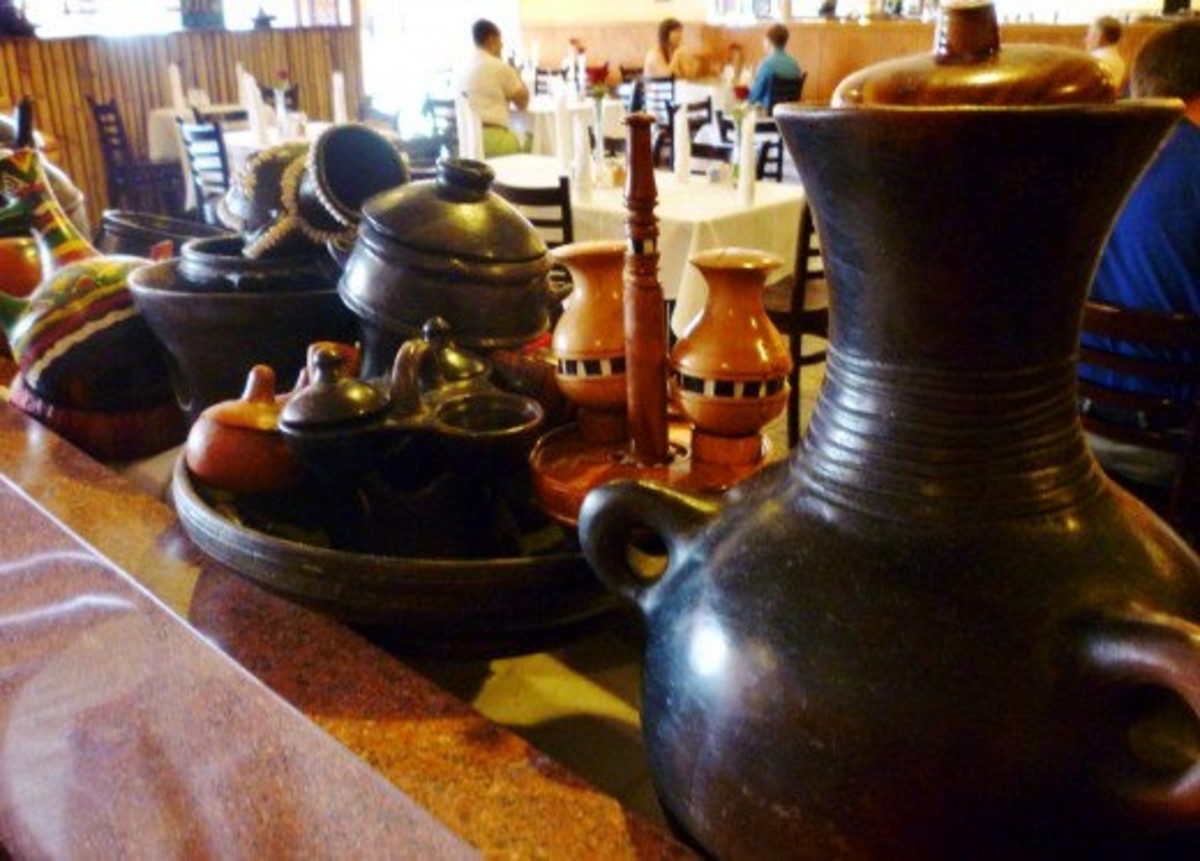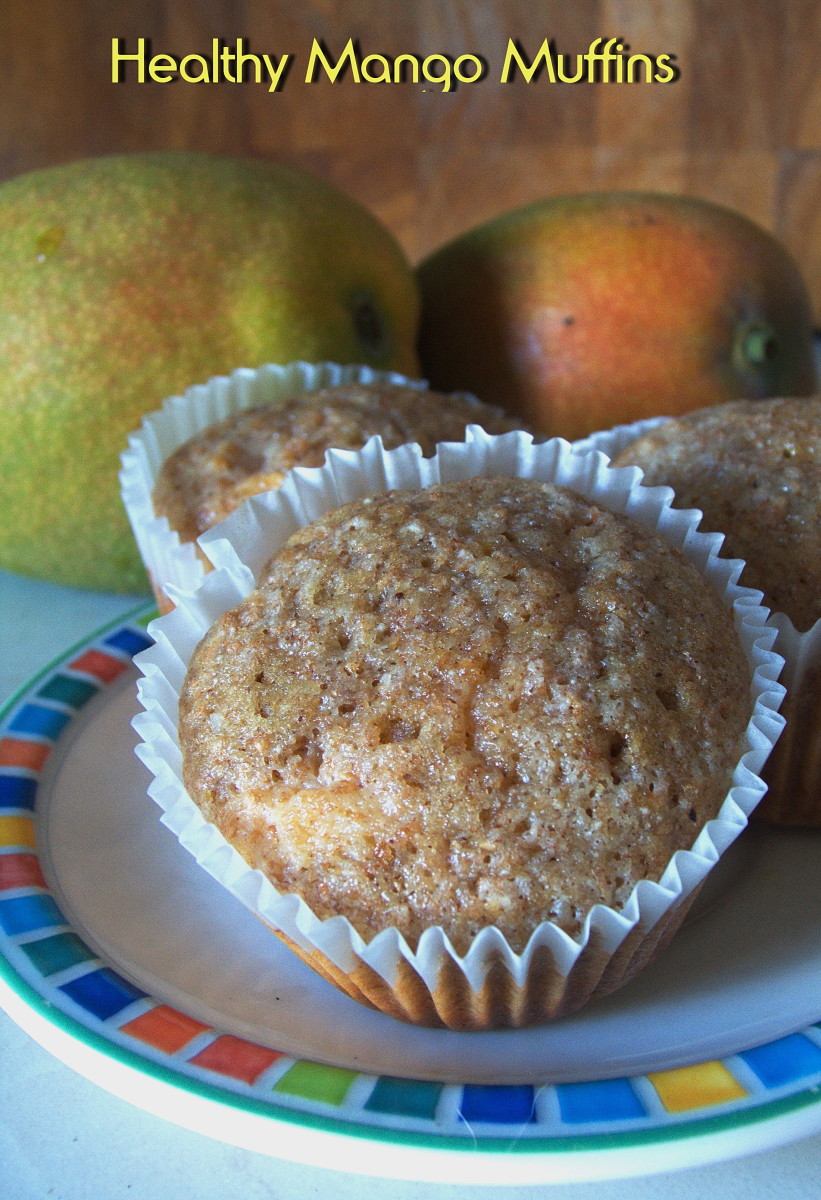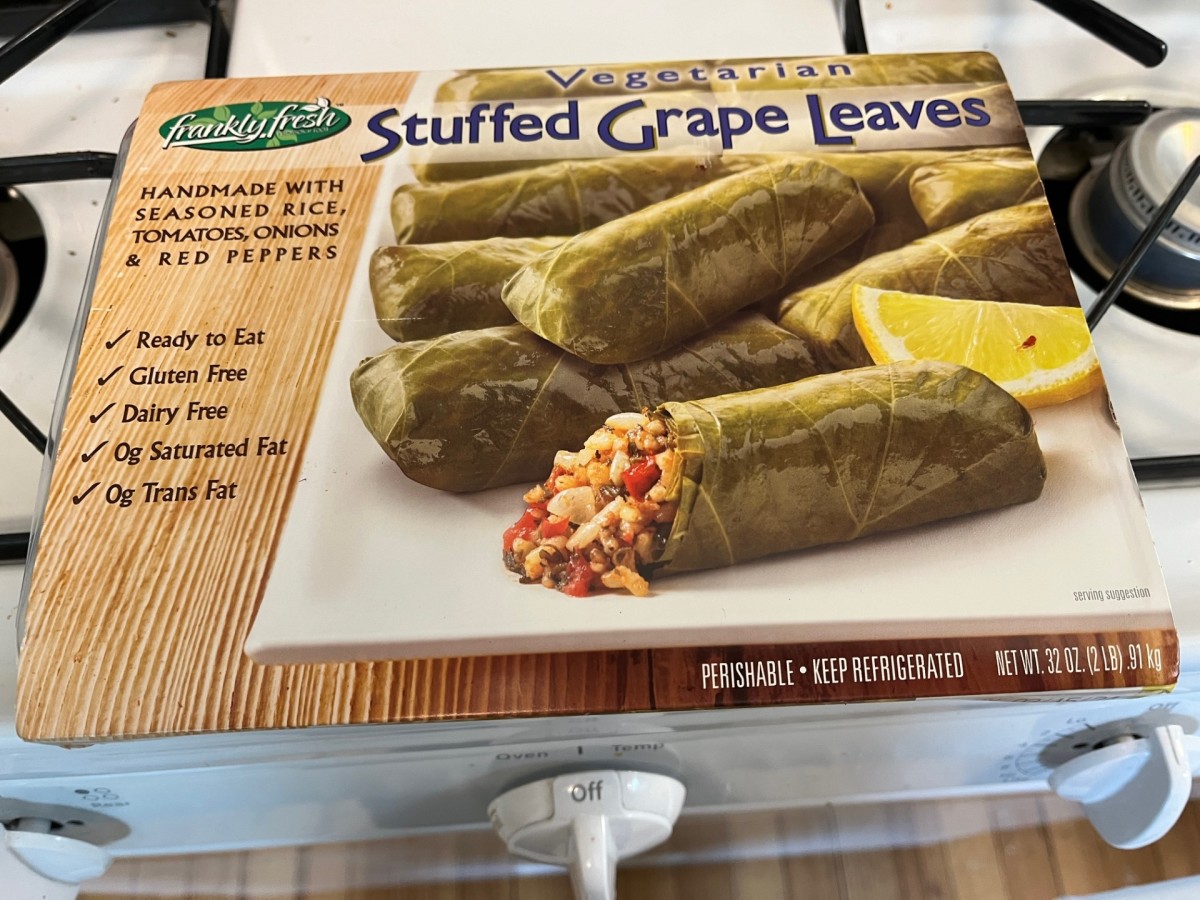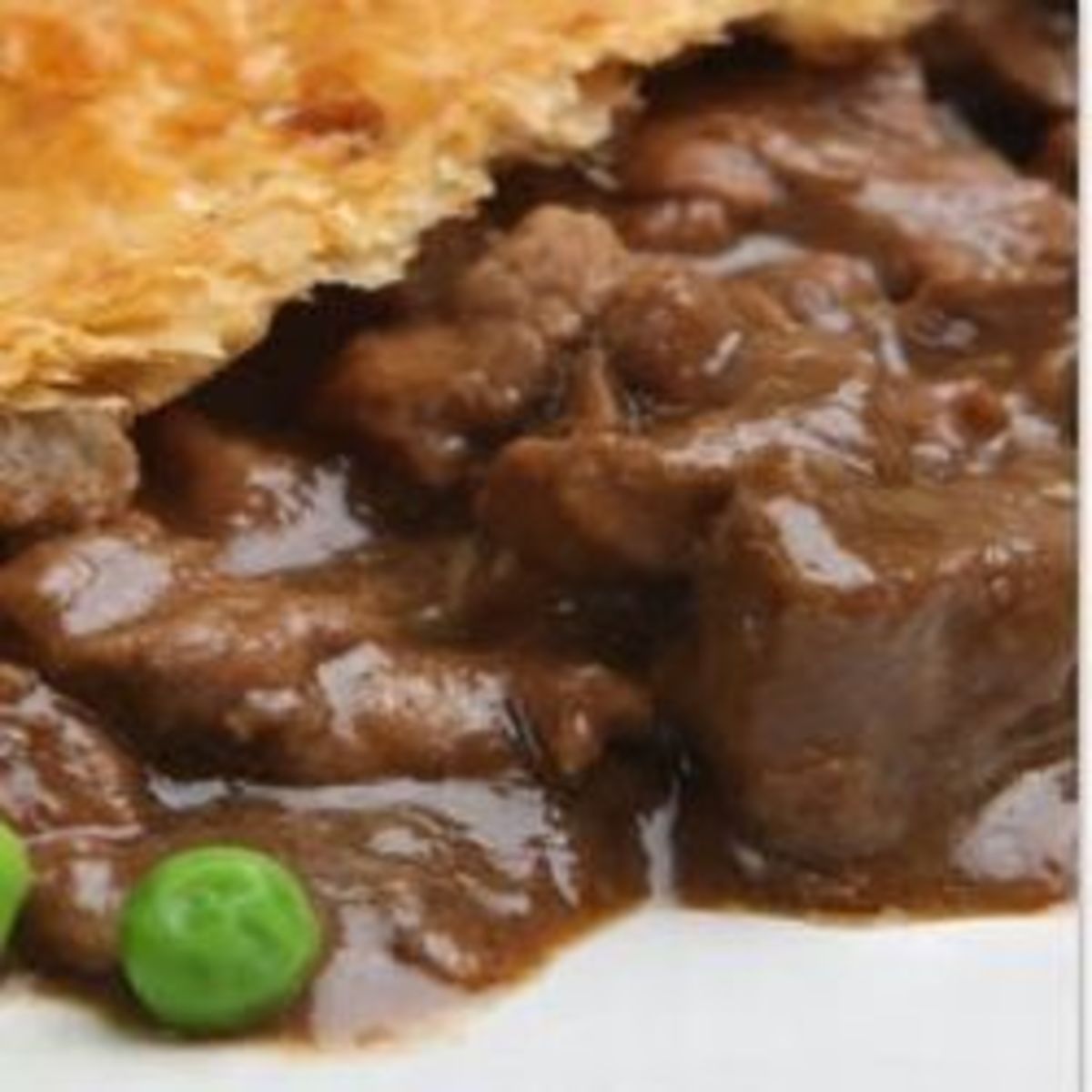Injera - Ethiopian national dish
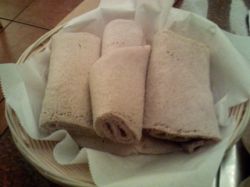
Injera is a necessity for an Ethiopian
They look like pancakes but dont call them that. I did and heard that it is so wrong. This is the number one staple food in Ethiopia and it is more like bread made from fermented batter.
Ingera is made from a cereal grain that is unique known as Tef. Though t'efs is unique to Ethiopia it is diverse in color and habitat. Tef is a member of the grass genus Eragrostis or lovegrass. T'ef will grow in many areas it is not an easy crop to farm. One problem in particular is that the weight of the grain bends the stem to the ground.
Tef is nutritional miracle food. It contains two to three times the iron of wheat or barley. The calcium, potassium and other essential minerals are also many times what would be found in an equal amount of other grains. Tef has 14% protein, 3% fat and 81% complex carbohydrate.
Tef is the only grain to have symbiotic yeast. Like grapes, the yeast is on the grain so no yeast is added in the preparation of ingera.
Tef is milled to flour and made into batter. the batter is allowed to sit so the yeast can become active. When the batter is ready it is poured on a large flat oven and allowed to cook. This process is much harder than it sounds and it is recommended buying from an Ethiopian Market or Restaurant in your area. Make sure it is Tef Ingera not a substitute Western grains.
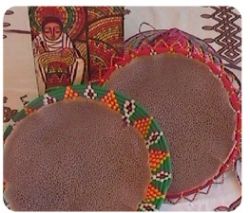
If you want to try - here is the recipe
Ingredients:
* 3/4 cup teff, ground fine
* 3 1/2 cups water
* salt
* sunflower or other vegetable oil
1. Mix ground teff with 3 1/2 cups water and let stand in a bowl covered with a dish towel, at room temperature, until it bubbles and has turned sour. This may take as long as 3 days. The fermenting mixture should be the consistency of pancake batter (which is exactly what it is).
2. Stir in salt, a little at a time, until you can barely detect the taste.
3. Lightly oil your largest skillet. Heat over medium-high heat. Then proceed as you would with a normal pancake or crepe. Pour in enough batter to cover the bottom of the skillet. About 1/4 cup will make a thin pancake covering the surface of an 8-inch skillet if you spread the batter around immediately by turning and rotating the skillet in the air. This is the classic French method for very thin crepes. Injera is not supposed to be paper thin so you should use a bit more batter than you would for crepes, but less than you would for a flapjack. It should be about 1/3 inch thick.
4. Cook briefly, until holes form in the injera and the edges lift from the pan. Remove and let cool.
Yields 10 to 12 injeras.
Here you can buy teff flour
This highly nutritious whole grain flour is made from the smallest grain in the world. Compared to other grains, it has a much larger percentage of bran and germ so it's a very good source of dietary fiber, protein and iron. Teff flour has long been a nourishing staple of highland Ethiopians. Now, you too can enjoy its light, unique flavor and bountiful nutrition. Gluten free. Bob's Red Mill products labeled gluten free are batch tested in our quality control laboratory. We use an Elisa Gluten Assay test to determine if a product is gluten free. All natural. 100% Whole grain, excellent source. Friend of the heart. All natural.
Keep the injera warm in a special basket
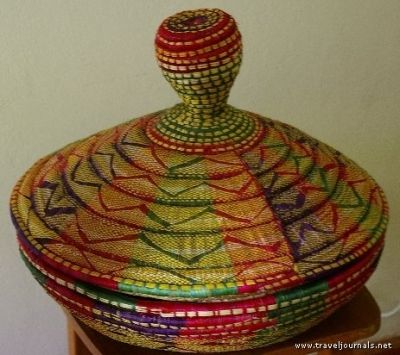
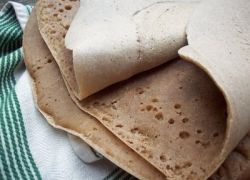
Recipe with ordinary flour
IN A LARGE BOWL, MIX
* 3 c Self-Rising Flour
* 1/2 c Whole Wheat Flour
* 1/2 c Cornmeal; or masa harina
* 1 tb Active Dry Yeast; (one
* 3 1/2 c Warm Water
Let set in large bowl, covered, an hour or longer, until batterRises and becomes stretchy. It can sit as long as 3-6 hours. WhenReady, stir batter if liquid has settled on bottom. Then whip in blender, 2 cups of batter at a time, thinning it with 1/2 - 3/4 cup water. Batter will be quite thin. Cook in non-stick frypan WITHOUT OIL over medium or medium-high heat. Use 1/2 cup batter per injera for a 12-inchpan or 1/3 cup batter for a 10-inch pan.
Pour batter in heated pan and quickly swirl pan to spread batter as thin as possible. Batter should be no thicker than 1/8-inch. Do not turn over. Injera does not easily stick or burn. It is cooked through when bubbles appear all over the top. Lay each injera on a clean towel for a minute or two, then stack in covered dish to keep warm. Finished injera will be thicker than a crepe, but thinner than a pancake. To serve, overlap a few injera on a platter and place stews on top (I think most kinds of spicy bean or veggie stews/curries would be great with this. For Ethiopian food, the spicier the better).
Or lay one injera on each dinner plate, and ladle stew servings on top. Give each person three or more injera, rolled up or folded in quarters, to use for scooping up the stews. I calculated that if you make 15 12-inch injeras, each would be about 120 calories, 3% CFF. For a more authentic injera, add 1/2 cup teff flour (teff is a kind of millet) andReduce the whole wheat flour to 1/4 cup. NOTES: Injera, a spongy crepe-like bread (slightly sour), is almost always eaten with Ethiopian stews.
If youve been to an EthiopianRestaurant, they probably used the injera as both plate and utensils. The injera are layered on aRound table and the stews are piled on top -- then more injera are used to scoop up and eat the stew. And of course once the stew is gone the injera underneath it are suffused with all the yummy juices. It takes a while to cook up each injera but itsReally easy.
Injera in Ethiopia
Beautiful photos of Injera making
Please click on these links to see how they cook injera outdoors. The photos are really beautiful and clear.
Where I stayed they cooked the injera in a room on the back yard. The smell is really intence and stay in your nostrils and clothes for a long long time.
- Carolyn Fords photos
The photos show step by step how to cook injera
So - when the injera is made
You will need the stews and other things to put on them. Without the spice Berbere - you cannot. So I start with the reciepes to make the special Ethiopian spice Berbere!
Spice sellers

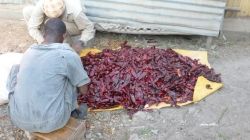
Berbere - a must
Every house wife has a recipe of Berbere. It is a mix of different spices and the Ehtiopian canno live without it. (I do not joke there)
Berbere can be made your own by try and testing different mixes. The ingrediences for a start can be:
10 eaches Dried red chiles
½ teaspoon Coriander seeds
5 eaches Cloves
Seeds from 6 green cardamom pods
¼ teaspoon Ajowan seeds
8 eaches Allspice berries
½ teaspoon Black peppercorns
½ teaspoon Fenugreek seeds
A small piece of cinnamon
½ teaspoon Ground ginge
Heat a heavy frying pan (without oil) and put in the chilies and other whole spices after 2-3 minutes. Dry roast over a medium heat until they darken, stirring frequently to prevent burning. Leave the spices to cool, then remove and discard the seeds from the chilies and crumble the chilies into the mixture. Grind everything, including the ginger, to a fine powder, and store in an airtight container for up to four months. Most of these spices can be found at an Indian or Middle Eastern market; hopefully there is one near you.
The best way to grind those spices is with a coffee grinder. If you don't have one of those handy, using a blender set on "liquify" works pretty well too. I have tried grinding a batch of garam masala with a mortar and pestle, and I had to give up and resort to a blender because it would have taken me hours otherwise. Good luck with your Ethiopian cooking !
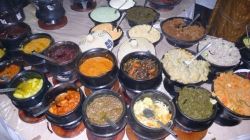
Berbere recipe with a sting
1 teaspoon Ground ginger
½ teaspoon Ground cardamom
½ teaspoon Ground coriander
½ teaspoon Fenugreek seeds
¼ teaspoon Ground nutmeg, preferably freshly grated
⅛ teaspoon Ground cloves
⅛ teaspoon Ground cinnamon
⅛ teaspoon Ground allspice
2 tablespoons Finely chopped onions
1 tablespoon Finely chopped garlic
2 tablespoons Salt
3 tablespoons Dry red wine
2 cups Paprika
2 tablespoons Ground hot red pepper
½ teaspoon Freshly ground black pepper
1½ cup Water
1 each To 2 tablespoons vegetable oil
In a heavy 2 to 3 quart saucepan (preferably one with an enamelled or non-stick surface), toast the ginger, cardamom, coriander, fenugreek, nutmeg, cloves, cinnamon and allspice over low heat for a minute or so, stirring them constantly until they are heated through. Then remove the pan from the heat and let the spices cool for 5 to 10 minutes.
Combine the toasted spices, onions, garlic, 1 tablespoon of the salt and the wine in the jar of an electric blender and blend at high speed until the mixture is a smooth paste. Combine the paprika, red pepper, black pepper and the remaining tablespoon of the salt in the saucepan and toast them over low heat for a minute or so, until they are heated through, shaking the pan and stirring the spices constantly. Stir in the water, 1/4 cup at a time, then add the spice and wine mixture. Stirring vigorously, cook over lowest possible heat for 10 to 15 minutes. With a rubber spatula, transfer the berbere to a jar or crock, and pack it in tightly.
Let the paste cool to room temperature, then dribble enough oil over the top to make a film at least 1/4 inch thick. Cover with foil or plastic wrap and refrigerate until ready to use.
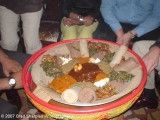
Doro Wat - Ethiopian stew
Chicken, lamb or minse meat
2 to 3 lbs chicken
9 ounces Tomato paste
3 Sticks butter
10 Hard boiled eggs slightly scored
3 pounds Onion fine chopped
2 larges Cloves garlic minced (or 2 tsp. powder)
1 teaspoon Ground black pepper
3 Heaping tb berbere
Remove skin from the chicken and score each piece slightly with a knife so the sauce can penetrate. In a large stew pot, melt the butter, then saute the onions and garlic for five minutes. Add berbere, followed by tomato paste, stirring occasionally while the mixture simmers about 15 minutes. A piece at a time, stir in the chicken, coating well with the sauce. Continue to simmer, adding enough water to maintain the consistency of a thick soup. When chicken is half done, after about 20 minutes, put in the hard boiled eggs. Cover and continue cooking until the chicken is tender. The dish is ready when the oil has risen to the top. Add black pepper and let sit until slightly cooled. Serve with injera.
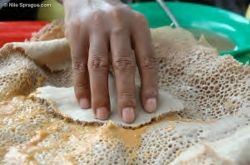
How to eat injera with wat
One - hand - art
You wash your hands thoroughly. Then you use only one hand when you eat. Most people use the right hand. Now you tear a bit of your roll of injera and use it to pick up the wat, lenses or stew you want to taste. If you find the food too spicy - do NOT drink anything. You can ease the fire through eating a bit of bread instead.
To eat it the Ethiopian way, pass around a tray of injera (flat bread), and place a large platter of wat in the center of the table so everyone can reach it. Tear off pieces of injera with your right hand. Fold the bread around bits of stew and eat, without touching you fingers to either the stew or your mouth (a trick that requires practice!).
A way to show affection to another person is to feed him a portion from the tip of your fingers. Only really good friends do this. =D
Useful links when you want injera with wat
- Injera.com
Deliver to your door step. If you want to eat injera without all the trouble to cook it. You can acutally order home delivery! But there are also Ethiopian restaurants in almost all cities. - Lots of recipes and tips
This is an excellent site when you want recipes from the native Ethiopians. It is doro, sallads, drinks and how to eat the Ethiopian way!
Blog about Injera!
What Is Injera? Injera, is Ethiopia’s traditional flat bread and is made from a local grain called Teff. Injera is a staple food throughout Ethiopia. How To Make Injera? To make Injera a cook… more →
- Wordpress blog
Ingera is important - Berbere is too

